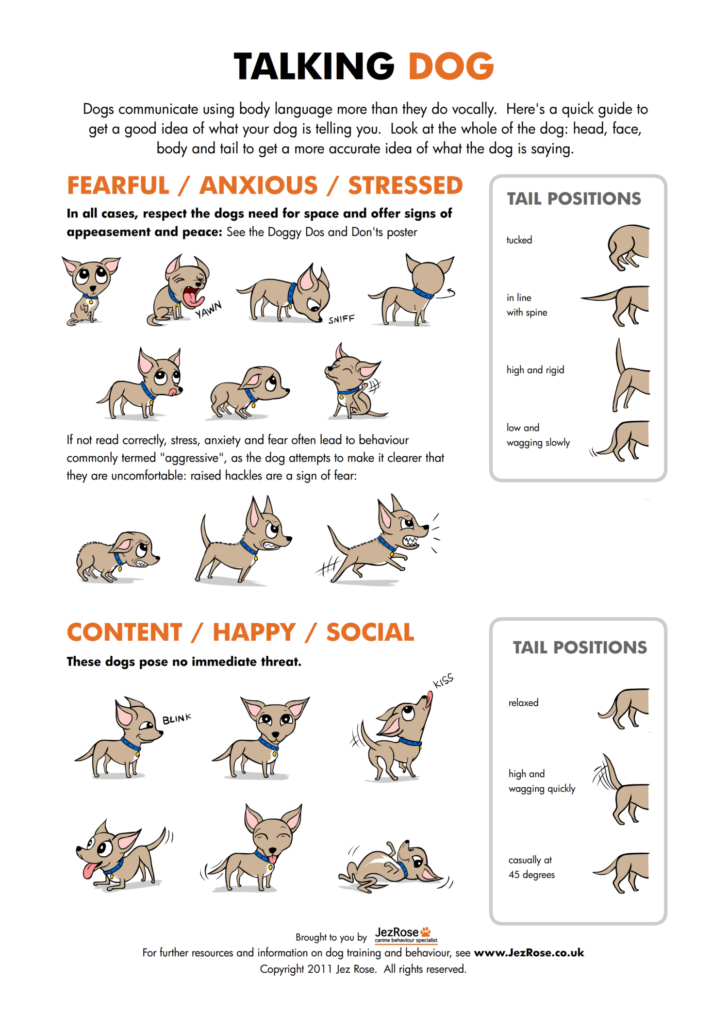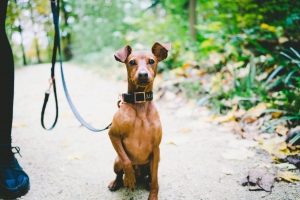Ask Crystal: Helping Tater’s Anxiety

Dear Crystal,
Help Tater! About 4 months we adopted an eighteen-month-old pug/chihuahua. Sadly, he came from a horrible hoarding situation. His owners were allowing their personal pet pug and chihuahua to freely breed and then putting the puppies into small pet carrier/crates for the duration of their lives. When animal control became involved, there were 68 dogs rescued from crates.
We knew there were going to be issues and with guidance from our vet we are addressing both situational anxiety and separation anxiety. With Composure Pro, a Thunder shirt and lots of exercise. We are seeing great improvement. However, he is growling more at strangers and other dogs, even though when allowed, he is very playful and kind to other dogs. Maybe, I’m over reading this as our vet says we’re making great progress…? How do we handle the growling? We live full-time on an RV and he absolutely loves it. When we prepare to move, he sits on the dash and can’t wait until he is in his seat and rolling down the road. But that has meant LOTS of stimuli for our little prince.
Any advice you have to help us make him feel safer, so he doesn’t feel afraid or abandoned if I leave him, would be so appreciated.
Thank-you,
Tater’s Mom
Dear Tater’s Mom,
First of all, thank you for giving Tater such a wonderful loving home. Rescuing dogs that come from terrible situations does often come with its challenges. Tater was not given the socialization required as a puppy to help him become able to deal with a variety of stimuli amongst other potential causes for his fearful behavior such as genetics. You are making progress and will likely experience some setbacks occasionally as well. Behavior modification is not a straight road and behavior changes from day to day.
My first suggestion is that you start to keep a diary of Tater’s days. We want to be tracking whether he is having a good day, bad or somewhere in between. You also want to track what went on that day. Did he encounter many strangers, many dogs, environmental stimuli, etc.? This will help you really narrow down all his triggers so that you can try to minimize his exposure to those. If you decide to work with a trainer going forward, this information is going to be very valuable to them.
 You will also want to make note of your dog’s threshold to those fear inducing triggers. How far away do the people or dogs need to be before your dog begins to react in the smallest ways? That means the reactions that come before the growling. This could be closing his mouth, staring, unable to listen to cues, uninterested in food or play, body weight back, tail tucked or hanging limp, ears back, lip licking, looking away, yawning and/or whale eye.
You will also want to make note of your dog’s threshold to those fear inducing triggers. How far away do the people or dogs need to be before your dog begins to react in the smallest ways? That means the reactions that come before the growling. This could be closing his mouth, staring, unable to listen to cues, uninterested in food or play, body weight back, tail tucked or hanging limp, ears back, lip licking, looking away, yawning and/or whale eye.
The majority of dog parents are able to pick up on the very large signals like growling but miss all the signals that came before and were the first indication of discomfort. Become a student of body language. I highly recommend a DVD called, “The Language of Dogs” by Sarah Kalnajs. There are so many signals that indicate discomfort and fear that we miss. A well-educated behaviorist or trainer will be able to point out his more subtle cues to you as well so you can recognize his discomfort earlier. This is going to be critical to working under his threshold.
Management is vital in working with a dog with fear. Every time he has an over threshold exposure it can sensitize him even further. I would imagine this would be difficult in an RV just because the amount of people that you probably encounter on a daily basis. Scope out walking areas before you go to an RV park. Try to choose parks that have lots of open space and are not overly crowded and noisy. When looking for walking spots, you are going to want to look for places that someone won’t creep up on you without you expecting it. You also want to be able to get behind something if you see someone coming so he can’t see them. I always look to make sure there is somewhere I can step off and avoid narrow areas where there is no other option but to walk past the trigger. Once you know what his threshold is that will help in determining the best locations for potty walks.
If he is growling at people, that is a request for space. Most aggressive behaviors are distance increasing requests, the dog needs space. We absolutely should never correct growling in any way as it is a good thing that he is giving warnings when he needs space. Punishing a growl gets you a dog that doesn’t give warning signals before they bite. What we should do instead is heed the dog’s request for space and get them away from that situation. Then we separately begin working on changing his feelings.
You want to think of what your training goal is. I would suggest at this point that the goal is for him to be comfortable walking around people and dogs without growling at them. You may have an ultimate goal of him being fine with people approaching him and petting him. That may or may not ever happen depending on how fearful he is. If he is truly afraid of new people, then it is not something that he is going to enjoy and it ends up being more for the person than the dog.
There are some training cues that you can teach him that will help to redirect him to you when you need his attention. Target is a very useful cue to get a dog to move where you want them to. Target means for the dog to touch his nose to your fingers. It’s a great way to get the dog to turn away from the trigger and towards you so that you can reinforce that attention while the trigger walks by. Find it means to search the grass with your nose when I say “Find It” and toss a treat in the grass. This is a great technique to distract dogs while their trigger goes by. It can also work to counter condition them to the trigger if they really enjoy playing it.
 Teaching focused loose leash walking is also a really important skill for any dog but even more so for fearful dogs. If the dog is checking in with you frequently then you will be able to get his attention when needed and very often, he may not even notice the triggers because he is so focused on you.
Teaching focused loose leash walking is also a really important skill for any dog but even more so for fearful dogs. If the dog is checking in with you frequently then you will be able to get his attention when needed and very often, he may not even notice the triggers because he is so focused on you.
Play is a great way to work with a fearful dog as well. We know that dogs are unable to play when they are feeling fearful so it is a great way to judge how they are feeling. It’s also something that they really enjoy doing so it can counter condition as well. Grab your dog’s favorite toy and stand far enough away so that he can see the triggers but will still play. If he stops to look at something, let him look as long as he isn’t reacting and just wait. Once he is ready to reengage, start offering the toy for play again. If he reacts or won’t play, either move further away or take a break.
Once you have worked on some management cues, you can begin to work with him on changing his feelings towards his triggers. Start at a distance where he is under threshold and totally comfortable and offer a treat every time he looks at a new person. Maybe pull up a chair and just watch people go by and treat him. We want the appearance of an unknown person to predict wonderful things like yummy treats, praise and play if he likes to play. We want him to go from worried about seeing a new person to, “Yay! A new person. Where is my treat?”.
In regards to other dogs, is he meeting the dogs on leash when he has an issue? Many dogs become reactive when on leash because the leash restricts the dog’s ability to get away and it can cause them to become fearful. When introducing to other dogs, he may need to be either off leash or on a long line so that it feels loose and like he isn’t on a leash. Avoid on leash greetings at all costs. It’s very normal for dogs to not like to greet on leash. Monitor closely during play sessions for signs of fear and either stop the play or make the dog take breaks. We cannot let interactions continue when one dog is not enjoying themselves.
If he is becoming reactive on leash at a distance to other dogs, the same skills that I mentioned for his fear of people would be recommended for dogs. It’s all the same concepts just different triggers.
It is wonderful that you are asking yourself, “How can I help Tater feel safe?”. In my experience, the first and best way to do that is to show the dog that you see that they are uncomfortable and to get them out of that situation. Never force any interactions. For example, some people will hold a treat in their hand for the dog to come get. What happens in that situation is the dog is forced to go closer than they feel comfortable because they really want the food. Instead, I suggest having people stand far enough away that the dog is comfortable and tossing a high value treat behind him and repeat many times. The dog will begin to close the distance as he feels comfortable. Everything needs to be at his pace and in his control.
You will want to frequently be reevaluating your training goals as you go. We can try our best to change the dog’s opinion about things but some things take many years or won’t ever change at all. You may find sometimes that something you thought was really important ended up not being that important at all in the long run. Good luck and happy training!
Until next time,
Crystal
Submit your own pet behavior question for Crystal here:







